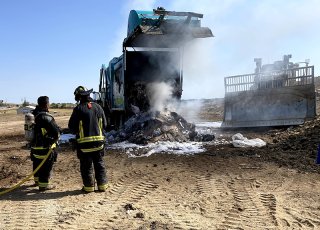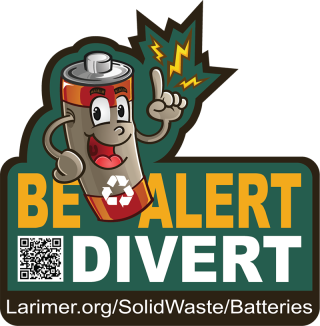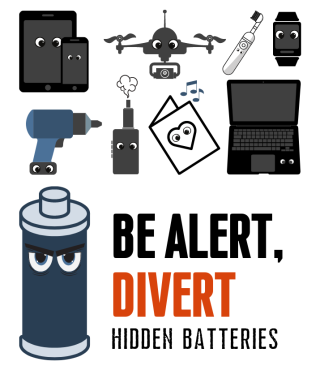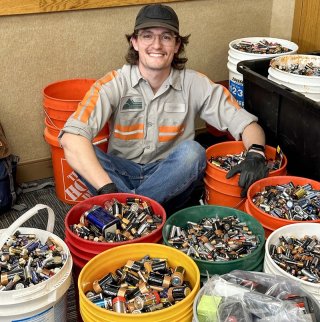Battery Collection in Action Case Study: Sparking Awareness for Battery Fire Prevention in Larimer County, Colorado
On this page:
Introduction
In northern Colorado, the Larimer County Solid Waste Department’s household hazardous waste facility is raising awareness about the risk of battery fires through the “Be Alert! Divert Hidden Batteries” campaign. The facility serves 370,000 residents, from rural mountain communities to urban areas like Fort Collins and Loveland. The facility accepts:
- Small batteries including household alkaline batteries.
- Lithium metal batteries.
- Lead-acid automotive batteries.
- Rechargeable batteries (under 300 watt-hours) such as lithium-ion, nickel-cadmium, and nickel-metal hydride batteries.
They currently do not accept e-bike, e-scooter, electric vehicle, or lithium car batteries.
Located next to the Larimer County Landfill, the facility is open five days a week and offers free hazardous waste drop-offs for residents. Households can access additional free battery recycling options at the Fort Collins and Loveland recycling centers and through third-party recyclers like Call2Recycle and Batteries Plus. Businesses can schedule hazardous waste drop-off appointments at the Larimer County facility. The County may charge these business fees.
Program Design and Implementation

Although the Larimer County household hazardous waste facility has collected batteries since 1996, batteries still end up in the trash due to a lack of public awareness, creating fire hazards. Many residents unknowingly dispose of batteries hidden inside devices like laptops, remotes, or vapes. Battery fires have occurred three to five times per month in Larimer County’s solid waste facilities, primarily from lithium-ion batteries. These fires have damaged garbage trucks and endangered workers at recycling centers and the landfill.
The facility operates with a small team of five staff who support battery and general hazardous waste collection. The County trains the staff to handle and repackage batteries safely. The County encourages customers to remove batteries, when possible, as loose batteries are easier to manage. If necessary, staff members remove batteries, and an approved recycler handles devices with embedded batteries. Staff visually inspect and manually sort batteries by chemistry and:
- Individually bag and surround lithium-ion pouch batteries with CellBlockEX, a mineral-based material that prevents and suppresses lithium-ion battery fires.
- Bag or tape the terminals of nickel-cadmium and nickel-metal hydride batteries if they exceed nine volts.
- Individually bag or tape the terminals of lithium-ion (non-pouch) batteries.
- Tape the terminals of lithium metal batteries.
Staff place sorted batteries in 30-gallon polyethylene drums and alkaline batteries into 55-gallon steel drums. County staff place lead-acid and automotive batteries on pallets. Staff ship damaged, defective, or recalled batteries in a Call2Recycle pail. The facility does not recycle on-site but instead ships all batteries to vendors like Call2Recycle and Interstate Batteries for recycling. The County funds battery collection and recycling through their solid waste budget, with 2024 costs totaling approximately $18,800, including $11,000 for alkaline, $6,000 for rechargeable (nickel cadmium, nickel-metal hydride, and lithium-ion), $1,000 for lithium metal, and $800 for vapes.
Despite established operations, the program struggled with low participation in battery recycling. In the winter of 2021, the household hazardous waste department addressed the growing concern over battery fires. With the landfill nearing capacity and the County building a new transfer station, the risk of fires in enclosed spaces increased. To mitigate this risk, the household hazardous waste facility launched an initiative to educate residents and businesses on proper battery recycling. Using department funding, they implemented a community-focused initiative that included a youth-led sticker contest, an online educational toolkit, targeted messaging, and expanded rural collection events.

Sticker Design Contests
To mitigate battery fire risks, household hazardous waste staff focused on educating residents about battery recycling. They launched a sticker design contest seeking participation from Colorado State University students in Fort Collins. When student interest was low, the contest opened to the public, and a local graphic artist created the winning design. The stickers included a QR code linking to the program’s website, which offered information on battery safety, fire prevention, and local recycling options.
After the contest opened to the public, a local elementary school art teacher used it as a project in her class. Students were enthusiastic about designing their own stickers that relayed the message about proper battery recycling, and a local print shop donated a sheet of stickers for each student’s design. This engaged younger children, who could share their knowledge with families.
Educational Toolkit

To broaden the campaign’s reach beyond classrooms, a household hazardous waste team member created an online repository of materials, including infographics, posters, fact sheets, social media posts, and newsletter blurbs about battery recycling. Using affordable tools, the staff member designed infographics without the need for a graphic designer. Recognizing that 13 percent of Larimer County’s population is Hispanic, they used online translation tools to develop bilingual materials for both English and Spanish speakers. The staff placed the repository, or "toolkit," on the department’s website for public access, to make battery safety and recycling information available to everyone, not just Larimer County residents.
Targeted Messaging to Vape Stores and Consumers
Alongside outreach initiatives, the household hazardous waste department targeted educational messaging toward vape stores and their consumers. Vapes, whether rechargeable or single use, often have embedded or sealed batteries. Some vape stores began collecting used products to help divert vapes from the waste stream. However, this effort imposed regulatory burdens on businesses, which must comply with stricter regulations if they collect more than 2.2 pounds of an acute hazard such as nicotine. To avoid these issues, department staff recommend individuals dismantle rechargeable vapes, remove the batteries, and discard them at the household hazardous waste facility, designated recycling centers, or third-party locations. Single-use vapes have sealed batteries, so staff recycle them separately, placing them in vermiculiteVermiculite is the mineralogical name given to hydrated laminar magnesium-aluminum-iron silicate that resembles mica in appearance. in 2- or 5-gallon buckets, alternating layers of vapes and vermiculite.
Expanded Battery Collection Access

Household hazardous waste staff prioritized battery disposal accessibility across Larimer County’s diverse geography. The household hazardous waste facility, centrally located between Fort Collins and Loveland, offers convenient drop-off options five days a week. However, for remote mountain communities in the western county, accessing the facility may require long drives. To address this, staff members organize one-day pick-up events in Estes Park, a rural mountain community. In one event, they collected half a truckload of batteries. Two staff members attend these events to collect batteries and transport them back to the facility for sorting, packaging, and shipping to a recycling vendor. In 2024, the cost for a one-day collection event was approximately $1,500, including shipping and recycling expenses.
What Works Well
The “Be Alert! Divert Hidden Batteries” campaign succeeded by emphasizing early education and accessible outreach. Shifting the sticker design contest to younger students increased participation and fostered environmental awareness early on. Children often share school lessons with their families, broadening the campaign's reach. The staff maintained low costs for the online toolkit by using free graphic design tools along with online translation tools to create bilingual materials for English and Spanish speakers. One-day battery collection events in rural mountain communities eased travel burdens and boosted recycling participation. These low-cost strategies effectively reached a wide audience and promoted battery safety awareness.
Challenges Encountered
Despite its success, the “Be Alert! Divert Hidden Batteries” campaign faces challenges in battery collection and participation:
- Mountain community residents are often reluctant to travel long distances to the household hazardous waste facility.
- Rising costs for packaging and shipping batteries add $10,000 to the department's annual budget.
- Local governments shoulder battery disposal costs.
- Lack of space in facilities limits battery collection.
- Personnel changes delay sticker and educational campaigns.
These challenges underscore the need for sustained resources, broader accessibility, and supportive state legislation for battery recycling.
Key Takeaways and Lessons Learned
Larimer County’s Hazardous Waste and Transfer Station Manager, Linda Hammett, emphasizes that the key lesson from the “Be Alert! Divert Hidden Batteries” campaign is simplicity. The household hazardous waste staff leveraged existing infrastructure, used free or affordable resources for the educational campaign, and engaged youth through sticker design contests. The team took advantage of the slower winter operations to focus on program implementation. Staff contributed creative ideas, enhancing community engagement.
Linda advises organizations starting a battery safety program to use existing funding sources or secure sustainable external funding. While one-time grants can initiate programs, challenges arise if funding ends—particularly if the public becomes reliant on the service. Reliable funding and enthusiastic staff are crucial for a successful program.
Insights and Next Steps

Larimer County saw an increase in collected batteries since 2019, suggesting the sticker contest and educational efforts reinforced the importance of battery collection and recycling. Vendor shipping procedures changed in late 2024 to accommodate larger drums, but most were shipped in 2025, possibly explaining the slight decline in 2024. Due to personnel changes, the educational campaign and sticker contest were inactive for a couple of years but restarted in February 2025. These efforts aim to expand the program by encouraging teachers to integrate battery safety and recycling into school curricula.
In May 2025, Colorado enacted Senate Bill 25-163, the Battery Stewardship Act, covering "portable batteries, medium-format batteries, or any battery sold loose or as an easily removable battery within a battery-containing product or motorized vehicle." This Act requires battery producers to fund statewide battery processing and recycling, with phased requirements from 2027 to 2030 including mandatory producer participation in a stewardship organization. For Larimer County, the Act would alleviate the public financial burden of battery disposal.
